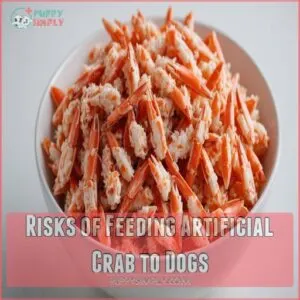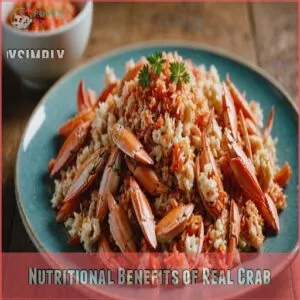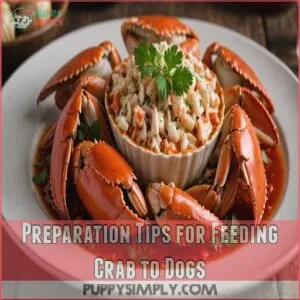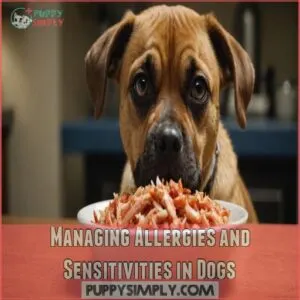This site is supported by our readers. We may earn a commission, at no cost to you, if you purchase through links.

Imagine giving your pup a tummy ache or even heart troubles just for a treat! It’s not worth the risk.
Instead, consider safe and nutritious alternatives that keep tails wagging.
And if you’re interested in exploring more dog-friendly foods, you might want to stick around for some tasty options!
Table Of Contents
- Key Takeaways
- Definition of Artificial Crab Meat
- Risks of Feeding Artificial Crab to Dogs
- Comparison to Real Crab Meat for Dogs
- Safe Alternatives to Artificial Crab Meat
- Managing Allergies and Sensitivities in Dogs
- Maintaining a Healthy Diet for Your Dog
- Frequently Asked Questions (FAQs)
- Can dogs eat imitation crab meat sticks?
- Can dogs eat imitation crab?
- Can dogs eat crab meat?
- Can dogs eat crab sticks?
- Can dogs get sick if they eat crabs?
- Can dogs eat crab salad?
- Is it okay for dogs to eat imitation crab meat?
- Can animals have imitation crab?
- Can dogs eat shrimp or crab meat?
- What is artificial crab meat made of?
- What are the ingredients in artificial crab meat?
- Can imitation crab cause long-term health issues in dogs?
- Are there dog treats with crab flavor?
- How often can dogs eat seafood generally?
- What signs indicate a dogs allergic reaction?
- Conclusion
Key Takeaways
- Artificial crab meat isn’t safe for dogs because it contains additives and high salt levels, which can cause digestive issues, allergies, and serious health problems.
- Imitation crab is made from processed fish (surimi) combined with flavorings and preservatives, not real crab meat, so it’s better to avoid feeding it to your dog.
- Instead of artificial crab, offer your dog safe and nutritious seafood options like salmon or tuna to ensure a healthy and happy pet.
- Monitor your dog for signs of allergies or digestive problems if they accidentally consume imitation crab, and consult your vet for guidance.
Definition of Artificial Crab Meat
You might be surprised to learn that artificial crab meat isn’t crab at all.
It’s actually a processed seafood product made from white fish, flavorings, and additives designed to mimic the taste and texture of real crab meat.
Composition of Surimi
Picture a seafood impostor on your plate – that’s artificial crab meat, also known as surimi.
It’s not the real deal from the ocean, but a clever creation made in food labs.
The main ingredient? Usually Alaskan Pollack, a mild white fish that’s ground into a paste.
This fishy foundation gets a makeover with starch, egg whites, and a bunch of additives to mimic crab’s texture and taste, which can lead to Sodium Poisoning Risks.
The result? A product that looks like crab, feels like crab, but isn’t actually crab.
It’s a budget-friendly alternative that’s become a staple in many kitchens.
Ingredients to Avoid
You’ve got the lowdown on surimi, but let’s talk about the no-go ingredients in artificial crab meat.
Your furry friend’s health is at stake here.
Watch out for these potential troublemakers:
- Preservatives and additives that can upset your pup’s tummy
- Artificial flavoring and red dye (like carmine) that might trigger allergies
- Excessive salt, which can lead to salt toxicity in dogs
- Potassium chloride and disodium inosinate, causing dehydration or respiratory issues
These ingredients aren’t part of a dog’s natural diet.
While a tiny nibble mightn’t hurt, it’s best to keep artificial crab off your pup’s menu.
Your dog’s wagging tail will thank you!
Risks of Feeding Artificial Crab to Dogs
You might think artificial crab is a harmless treat for your furry friend, but it can actually pose several health risks.
From digestive issues and allergies to heart problems and obesity, feeding your dog imitation crab meat could lead to unexpected consequences.
Digestive Issues and Allergies
Ever wondered why your pup’s tummy rumbles after a sneaky bite of artificial crab?
It’s no fish tale – this faux seafood can trigger digestive issues and allergies in dogs.
The additives and preservatives in imitation crab might lead to stomach pains, vomiting, or even food sensitivity, which is why it’s important to explore crab meat dog allergy products that cater to canine needs.
Keep an eye out for signs of gastrointestinal upset.
If your furry friend shows symptoms, it’s best to steer clear of this tricky treat and stick to dog-friendly snacks.
Heart Problems and High Blood Pressure
While digestive issues are a concern, artificial crab’s high sodium content can wreak havoc on your pup’s heart.
This salty snack may lead to high blood pressure and heart problems in dogs.
Smaller breeds are especially at risk.
Your vet would advise against these high-sodium foods, as they can cause serious cardiac issues.
Keep your furry friend’s ticker in top shape by avoiding sodium toxicity.
Obesity and Respiratory Issues
Heart issues aren’t the only concern with artificial crab.
It’s a sneaky culprit for dog obesity.
The high-calorie content and artificial flavors can lead to unhealthy weight gain, putting stress on your pup’s joints and organs.
Plus, some dogs may develop respiratory issues from additives like carmine.
Keep an eye out for wheezing or coughing after eating imitation crab.
Your furry friend’s health is worth more than a quick treat!
Comparison to Real Crab Meat for Dogs
While artificial crab meat poses risks for your dog, real crab can be a safe occasional treat when prepared properly.
You’ll want to know the nutritional benefits, preparation tips, and recommended serving sizes to make sure your furry friend’s safety and enjoyment.
Nutritional Benefits of Real Crab
Real crab meat offers notable benefits for dogs, making it a nutritious choice compared to artificial alternatives.
Packed with Omega 3s, crab supports various health aspects:
- Crab for Weight Management: Promotes a healthy weight due to its lean protein content.
- Crab & Joint Health: Aids in reducing joint inflammation.
- Crab for Skin & Coat: Enhances skin and fur condition, promoting natural shine.
Preparation Tips for Feeding Crab to Dogs
Imagine the benefits real crab meat offers. Now, let’s make sure you prepare it safely for your dog’s treat time.
First, thoroughly cook and remove all sharp shells. Stick to cooking methods like boiling or steaming. Choose safe seasonings, like a sprinkle of parsley, avoiding salt. Keep allergy concerns in mind to protect your pet’s health.
| Preparation Step | Action Required | Why It’s Important |
|---|---|---|
| Crab shell removal | Remove all shells | Prevents choking hazards |
| Cooking methods | Boil or steam | Ensures safety and digestibility |
| Safe seasonings | Use parsley, avoid salt | Maintains dog health |
| Crab frequency | Moderate treats | Prevents digestive issues |
| Allergy concerns | Monitor reactions | Safeguards against allergies |
Recommended Serving Sizes for Dogs
Considering dog weight, age factors, and breed differences, offer your furry friend real crab as a treat, not a meal, to complement their canine diet.
Serve 1 tablespoon per 10 pounds of body weight, focusing on serving frequency.
This method helps your dog enjoy dog-friendly foods safely, minimizing risks associated with spoiled or contaminated ingredients, such as those found in spoiled meat which can lead to food poisoning and long-term health issues like bacterial contamination, minimizing risks like salt ion poisoning or food allergies in dogs from imitation crab meat.
Safe Alternatives to Artificial Crab Meat
When considering artificial crab meat for your dog, it’s essential to note that even real crab should be fed in moderation due to its potential health risks, such as high iodine risks. When you’re searching for safe alternatives to artificial crab meat for your dog, consider nutritious options like salmon or tuna.
These fish are packed with omega-3 fatty acids, making them a tasty and healthy choice for your furry friend.
Nutritious Seafood Options for Dogs
If you’re swapping out artificial crab meat, consider these nutritious seafood options for your furry friend.
When introducing new seafood options like crab, make sure you follow safe feeding guidelines, such as removing breading and excess oil, as recommended in this guide on crab cakes for dogs.
- Salmon: It’s rich in Omega-3 benefits, boosting pet health and coat shine.
- Tuna: A suitable choice, but in moderation to prevent mercury exposure.
- Homemade Fish Treats: Perfect for puppies; they’re delicious and safe.
These options provide pet nutrition and a happy pup!
Other Protein Sources Suitable for Dogs
So, you’ve explored dog-safe fish; let’s look at other protein options.
Chicken and turkey are popular, but what about beef alternatives?
You can find a wide array of dog food brands that offer a variety of protein options, including beef, lamb, and even fish-based formulas.
Plant-based options exist, but homemade dog food offers the most control.
Remember, always check for sensitivities.
| Protein Source | Benefits | Considerations | Potential Issues |
|---|---|---|---|
| Chicken | Lean, readily available | Can cause allergies in some dogs | Digestive upset |
| Turkey | Lower in fat than chicken | More expensive than chicken | Allergies |
| Beef (lean cuts) | Good source of iron | High in fat if not lean | Digestive upset |
| Plant-based proteins | Can be part of a balanced diet | Make sure they’ve a complete amino acid profile | May not be complete protein |
Important Considerations for Dog Owners
Rethinking your dog’s snack options?
While imitation crab meat might seem tempting, opt instead for nutritious alternatives.
Consider crafting homemade dog treats using safe ingredients like chicken or turkey.
They’re not just tasty; they’re packed with protein, aiding in dog weight management.
Always be mindful of pet allergies and remember, veterinarian advice is paramount when introducing new foods to your dog’s diet.
Managing Allergies and Sensitivities in Dogs
When managing allergies and sensitivities in dogs, it’s important to understand their symptoms and triggers, especially with seafood.
Identifying these early can help you prevent uncomfortable reactions and make sure your furry friend stays happy and healthy.
Common Food Allergies in Dogs
Did you know dogs can have food allergies too?
Recognizing these allergies helps keep your pup healthy and happy.
Common culprits include:
- Chicken allergies: A frequent irritant.
- Artificial coloring in dog food: Often problematic.
- Grain-free diets: Sometimes beneficial, but not always.
- Additives like MSG: Can cause sensitivity.
Understanding these triggers is essential to managing your dog’s diet and ensuring their well-being.
Symptoms of Seafood Allergies in Dogs
You might spot some telltale signs of seafood allergies in your pup.
Keep an eye out for skin rashes, vomiting, dog diarrhea, or breathing trouble.
If you suspect your dog has a seafood allergy, you can find products and solutions specifically designed for dog seafood allergy relief.
Itchy ears are another red flag.
If your dog recently nibbled on imitation crab meat and starts showing these symptoms, they may be dealing with seafood allergies.
Protect them by noting these changes and reacting swiftly.
Identifying and Managing Allergies in Dogs
Allergies in dogs are like a puzzle waiting to be solved.
Identifying common dog allergies involves careful observation and allergy testing.
If your furry friend suffers from imitation crab meat reactions, managing symptoms through dietary changes and preventative measures is essential.
Switch to lean proteins and dog-friendly seafood, avoiding crab flavoring and artificial food colorings to keep your pup healthy.
Maintaining a Healthy Diet for Your Dog
Ensuring your dog maintains a healthy diet is essential for their well-being and longevity, just like skipping the occasional donut for yourself.
By focusing on balanced nutrition and being mindful of food allergies, you can help your furry friend thrive.
Importance of Balanced Nutrition for Dogs
Understanding your dog’s nutritional needs is key to their well-being.
A balanced diet prevents canine health problems and keeps your furry friend happy.
Think of it like this: you wouldn’t eat junk food all day, right? Neither should your dog!
Proper nutrition impacts everything from their coat to their energy levels.
Poor dog food quality can lead to obesity and other issues.
Here’s what you should focus on:
- High-quality dog food brands, such as those offering hypoallergenic dog food, are essential for managing allergies and skin issues in dogs. High-quality dog food brands
- Appropriate feeding schedules
- Protein-rich foods
- Homemade dog food (when done correctly)
Remember, omega-3 fatty acids are also important!
Consult your vet for personalized advice on your dog’s diet.
They can help you create a plan that fits your dog’s specific needs and age.
Don’t let poor nutrition put your best friend at risk.
Managing Food Allergies and Sensitivities in Dogs
When managing your dog’s food allergies, it’s essential to stay proactive.
Identifying common allergens like salt and seasonings helps keep their diet safe and prevents issues like irregular bowel movements and dog respiratory problems, including dog asthma.
Consider crafting homemade allergy-friendly recipes and understanding allergy testing to pinpoint exact triggers, such as considering a best dog food for allergies.
This awareness aids in managing food reactions efficiently.
For clarity, here’s a handy table:
| Issue | Solution |
|---|---|
| Irregular Bowel Movements | Identify problematic foods |
| Dog Respiratory Problems | Avoid allergens such as seasonings |
| Managing Food Reactions | Undergo allergy testing |
Frequently Asked Questions (FAQs)
Can dogs eat imitation crab meat sticks?
Think of imitation crab sticks as a box of colorful crayons—not meant for your dog’s health.
Packed with additives and preservatives, they can cause stomach issues and high blood pressure.
It’s best to skip sharing them altogether.
Can dogs eat imitation crab?
Imitation crab isn’t the best treat for dogs.
It contains additives, preservatives, and high salt levels that can upset your dog’s tummy and lead to health troubles.
Stick to natural snacks to keep your pup happy and healthy.
Can dogs eat crab meat?
Crab meat is a lean, protein-rich treat that dogs can safely enjoy in moderation, like 1 tablespoon per 10 pounds of body weight.
Moderation is key, so don’t go overboard.
Always cook it thoroughly and remove all shells to avoid health issues.
Can dogs eat crab sticks?
No, those aren’t a good idea for your pup. They’re packed with artificial ingredients that can upset their tummy or even cause more serious problems. Stick to dog-friendly treats instead!
Can dogs get sick if they eat crabs?
Your dog might get a stomachache from eating crab, as ingesting hard substances like crab shell fragments can cause gastrointestinal lacerations and intestinal blockages. Your dog might get a stomachache from eating crab.
While plain, cooked crab is usually safe in small amounts, raw crab and shells pose risks.
Watch for vomiting or diarrhea, and check with your vet if concerned.
Can dogs eat crab salad?
Ever wondered why a tasty crab salad isn’t great for your dog?
It’s packed with seasonings and ingredients like onions and mayonnaise that aren’t dog-friendly.
Stick to plain, cooked crab in small amounts for safety.
Is it okay for dogs to eat imitation crab meat?
Feeding imitation crab meat to dogs isn’t a great idea.
It contains additives, preservatives, and high salt content that can harm your pup.
For a nutrient-rich alternative, consider adding small amounts of anchovies for dogs, which are an excellent source of omega-3 fatty acids, to your dog’s diet. Opt for natural treats instead, ensuring your dog’s diet remains healthy and safe.
Can animals have imitation crab?
Many animals, especially pets like dogs and cats, shouldn’t eat imitation crab.
It’s packed with additives, preservatives, and salt, which can cause health problems.
Always stick to pet-safe treats to keep them healthy and happy.
Can dogs eat shrimp or crab meat?
Why risk your dog’s health with crab or shrimp when safety comes first. Tuna alternatives like Skipjack tuna options can be just as hazardous, so it’s crucial to consider the risks?
Cooked crab, minus seasonings and shells, is safe in small amounts.
Shrimp needs thorough cooking and shelling.
Monitor for allergies or digestive issues.
What is artificial crab meat made of?
Artificial crab meat, or imitation crab, is made from a white fish paste called surimi.
It includes crab flavoring, preservatives, and additives like salt and food coloring.
It’s designed to mimic the taste and appearance of real crab.
What are the ingredients in artificial crab meat?
Think of imitation crab as a culinary chameleon; it’s mainly white fish paste, but also contains preservatives, flavorings, and potentially harmful additives like salt and food colorings.
You should always check the ingredients list carefully.
Can imitation crab cause long-term health issues in dogs?
Feeding your dog imitation crab can lead to long-term issues like digestive problems, obesity, and high blood pressure due to its additives and high salt content.
Regular consumption isn’t healthy and can cause serious health concerns over time.
Are there dog treats with crab flavor?
You’ve got a treasure trove of options for crab-flavored dog treats out there!
They’re usually made with natural, safe ingredients.
Always double-check the label for quality and consult your vet before trying something new.
How often can dogs eat seafood generally?
Offer seafood to your dog once or twice weekly in small amounts.
Stick to plain, cooked options like salmon or tuna, avoiding bones and seasonings.
Make sure it’s safe, as some dogs may have allergies or intolerances.
What signs indicate a dogs allergic reaction?
Worried you’re missing signs of a dog’s allergy?
Keep an eye out for itching, red skin, swelling, sneezing, vomiting, or diarrhea.
Recognizing these symptoms early helps prevent complications.
Think of it as your pup’s SOS signal!
Conclusion
Regarding your dog’s diet, artificial crab meat is like a wolf in sheep’s clothing.
Packed with unhealthy additives, it poses risks from stomach troubles to potential allergies and more.
Opt for real, nutritious alternatives like genuine seafood or lean meats that keep your furry friend both happy and healthy.
By avoiding imitation crab, you’ll create a safer, more balanced diet, steering clear of the perils artificial crab meat may bring.














